Tel Hazor National Park and Hazor Antiquities Museum
Tel Hazor National Park in northern Israel shows the remains of Hazor, the largest fortified city in the country during the Israelite period.
Note: Tel Hazor National Park is also a UNESCO World Heritage Site.
Table of Contents
Map
Tel Hazor National Park is located next to Kibbutz Ayelet HaShahar, between Rosh Pina and Metula. And Hazor antiquities museum is situated at the entrance to Kibbutz Ayelet HaShahar.
Directions for drivers: Link to Waze and Link to Google Maps
Directions for public transport: Link to Moovit
Interactive map of the area:
Note: you can find maps of Tel Hazor below.
Tel Hazor National Park
We will start our visit at Tel Hazor National Park and then drive to the nearby Hazor Antiquities Museum.
Opening Hours
Sunday – Thursday and Saturday: 8:00 – 17:00 (16:00 in winter).
Friday: 8:00 – 16:00 (15:00 in winter).
On holiday eves, usually 8:00 – 13:00.
Note: Since the pandemic, the Israel Nature and Parks Authority has started limiting the number of people in each park. Thus, reservations are recommended through the official site (you can find the link below).
Entrance Fee
Adult 24 NIS, child 10 NIS, and student 20 NIS. Free for National Parks annual subscribers.
If you visit multiple National Parks, consider purchasing a combo ticket. Additional information is available at National Parks and Nature Reserves.
Note: opening hours and ticket prices were updated in February 2022. In any case, recheck the official site before visiting.
The Reason We Decide to Visit Tel Hazor
Recently my wife finished reading: “1177 B.C.: The Year Civilization Collapsed (Turning Points in Ancient History)” by Eric H. Cline. This book talks about the Late Bronze Age Collapse. Many Kingdoms fell like dominoes throughout just a few decades – no more Minoans, Mycenaeans, Trojans, Hittites, or Babylonians. The thriving economy and cultures of the late second millennium B.C., which had stretched from Greece to Egypt and Mesopotamia, suddenly ceased to exist.
Over the last few decades, archaeologists have built up a steady compilation of data on the Late Bronze Age cities. Using this data, the author analyzes different theories about what caused this collapse.
There are many possible reasons. Starting from the “Sea Peoples” mentioned in the Egyptian scroll, natural disasters like earthquakes and regional climate change were responsible for destroying cereal crops. The reason could be one, none of this, or a combination of them. There is still no accepted theory. And we will return to this question later on in this post.
In his book, Eric H. Cline mentions different Late Bronze Age cities, one of which is Tel Hatzor. Tel Hazor National Park is a UNESCO World Heritage Site, and we have never visited it. Thus, one Saturday, we decided to check it out.
Tours
When we arrived, it turned out that we were not the only ones who had never visited this site before. It is not a popular site. We were the only visitors before 10:00. A volunteer guide met us, and we received a private 90 min tour in Hebrew. It was fascinating, and I would recommend it if you have such an option.
You can either check the Israel Nature And Parks Authority’s site or call Tel Hazor at 04-6937290 and ask about tours.
The Largest Tel In Israel
Before starting our visit, let’s begin with a fundamental question: What Does Tel Mean? Megiddo National Park is also a Tel, and you can find an answer to this question in the linked article.
View from the first viewpoint:

At first glance, it does not look like much. But it is the lower city. Here is another photo of the sign:

Note: As the photo above shows, all signs are in Hebrew and English. But joining a tour is still way better.
Let’s make a small jump forward in time to show some perspective. After visiting Tel Hazor National Park, we went to the Hazor antiquities museum (near the entrance to Kibbutz Ayelet HaShahar). Here is a map of Hazor that we saw at the museum:
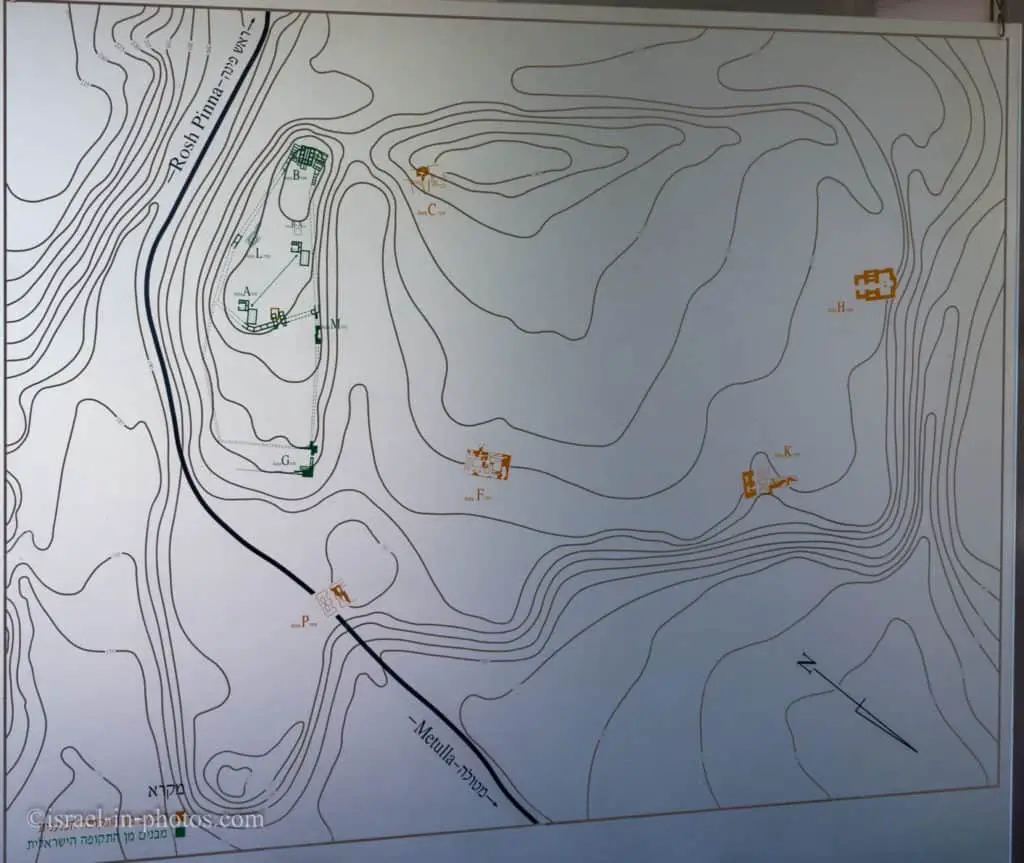
As you can see, the city is divided into two parts: the Acropolis (the upper town on the left), covering 120 dunams (30 acres), and the lower city (on the right), covering about 700 dunams. It is estimated that about 1,000 people lived in the Acropolis and another 20,000 people in the lower city. For a town around 1750 BCE, it was a huge one. It is also the largest Israeli Tel (mound).
So, why is almost the whole lower city covered? That is a question of money and funding. But keep in mind that it is an active archaeological site. Students from Israel and abroad dig there as part of their studies every summer. And for example, in 2013, they found a Sphinx of an ancient Egyptian king.
Location Location Location
Why was Hazor a big city? The location is one of the main reasons. Let’s look at the following map (displayed in the Hazor antiquities museum):
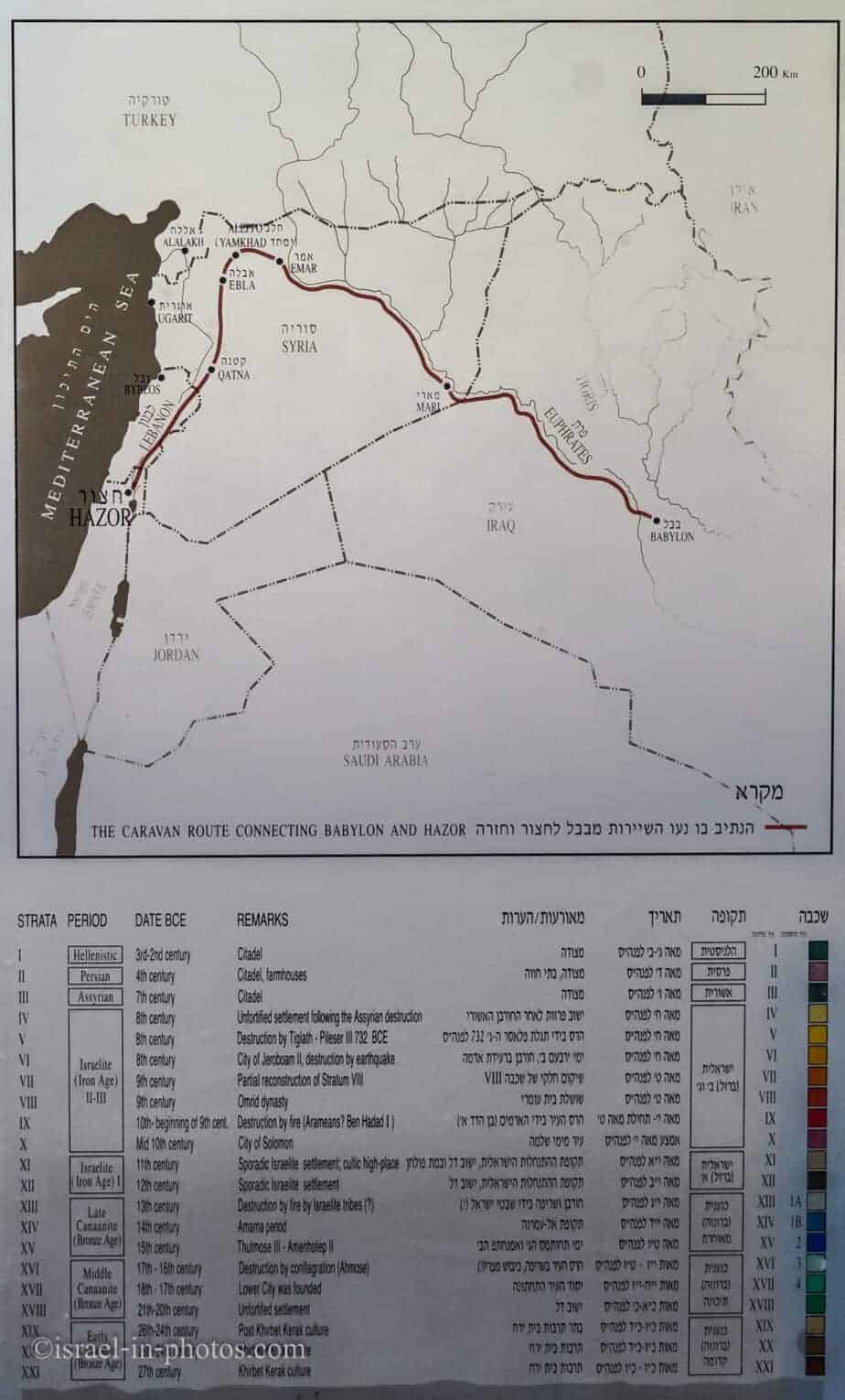
In the diagram above, you can see the red caravan route. It is part of the Via Maris (Latin: “way of the sea”). It is an ancient trade route dating from the early Bronze Age, linking Egypt with the northern empires of Syria, Anatolia, and Mesopotamia.
Hazor was on Via Maris, which allowed it to earn money from facilities for traders and have extensive trade connections with its neighbors. Also, in the image above, you can see a list of different strata. In Hazor, 21 different layers were found. This location remained important for people over many years and was reused and rebuilt many times.
Here is another photo from the Hazor antiquities museum showing a map with the origins of different artifacts that were found in Hazor:
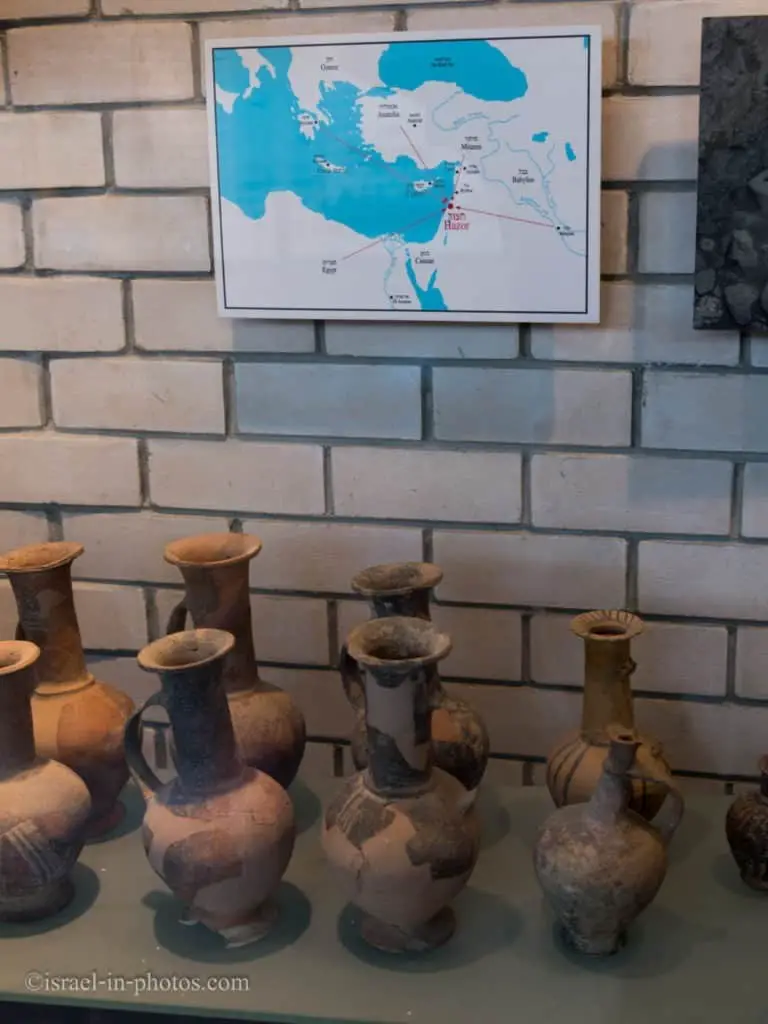
One of the mentioned places on the map above is Mycenae. Several years after visiting Tel Hazor, we visited Greece and Archaeological Site Mycenae. And in the museum at Mycenae, we saw stamps just like at Hazor Antiquities Museum. And today, we are talking about globalization, but this term could also be relevant to 2 BCE.
After this introduction, let’s step into the Acropolis.
Acropolis
Solomonic Gate
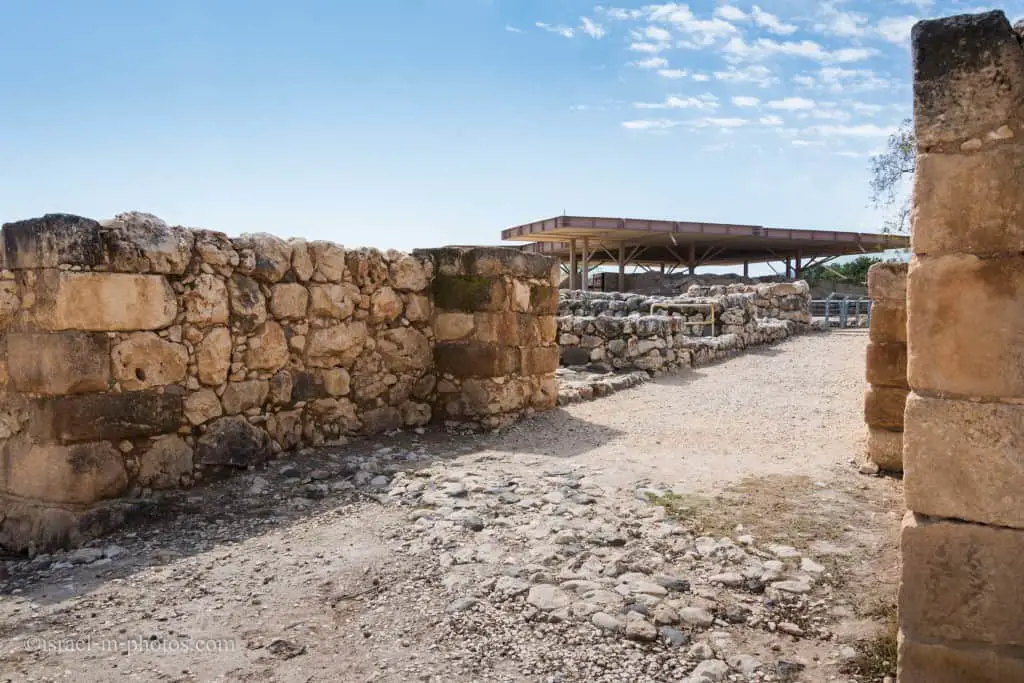
The gate you can see above is called Solomonic Gate (though our guide said there is a far-fetched relation to King Solomon). Interestingly, it is a six-chambered gate (as you enter, there are three chambers on each side). Similar gates were found in Megiddo and Gezer. One explanation is that these gates were all built by the same government.
A gate with six rooms and two towers, dated to the 10th century BCE. The gate was built in a form that was common in this period and is similar to the gates at Gezer and Megiddo. To the south of the gate are the remains of a casemate city wall from the same period (made of two parallel walls with a space between them, divided into chambers by partitions). Beneath the middle room in the southern wing of the gate, the basalt threshold of a Canaanite temple was found.
Note: unless stated otherwise, all quotes were taken from the official site.
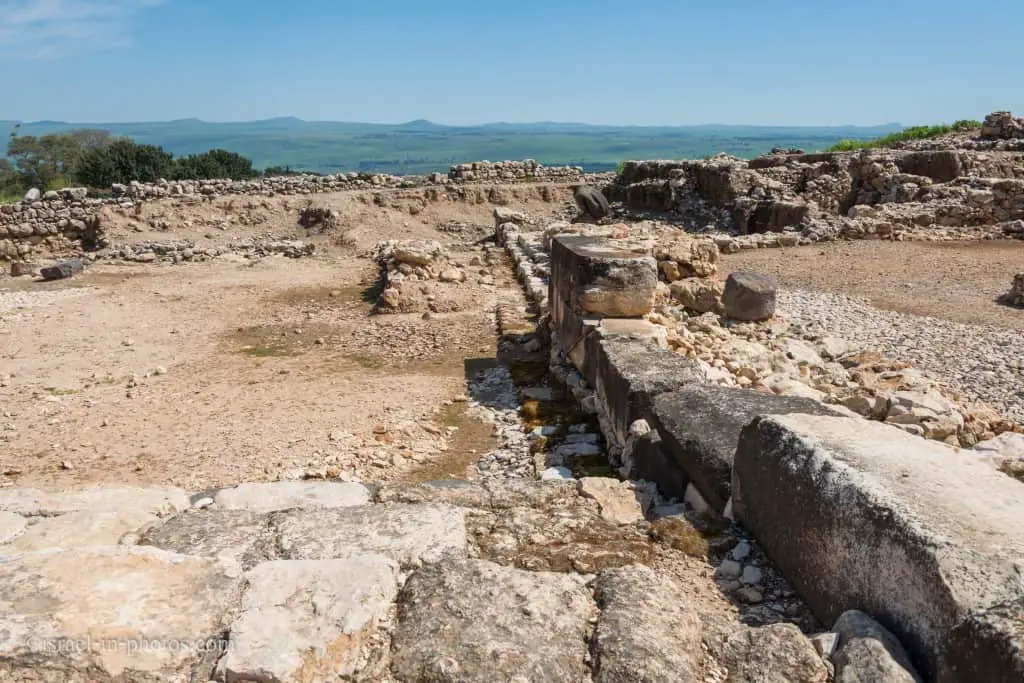
Hazor has three water systems. The Canaanites built two, and one the Israelites. Here you can see drainage leading to one of them (Canaanite). Unfortunately, this water system is closed to the public.

There are several remains of Canaanite Temples, and here is one of them:
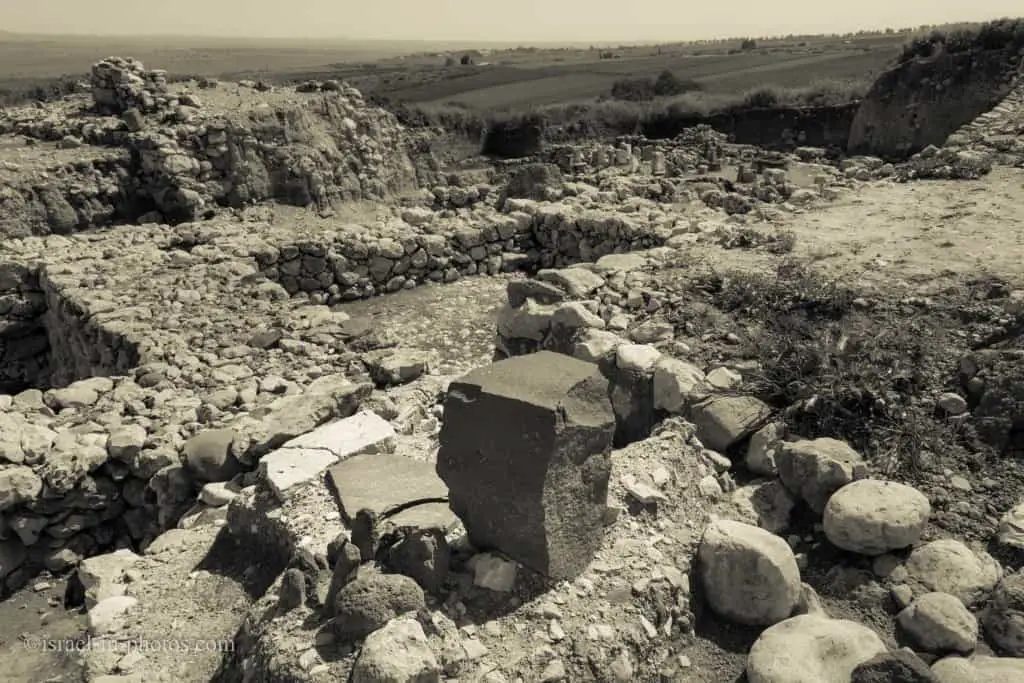
The “Temple”
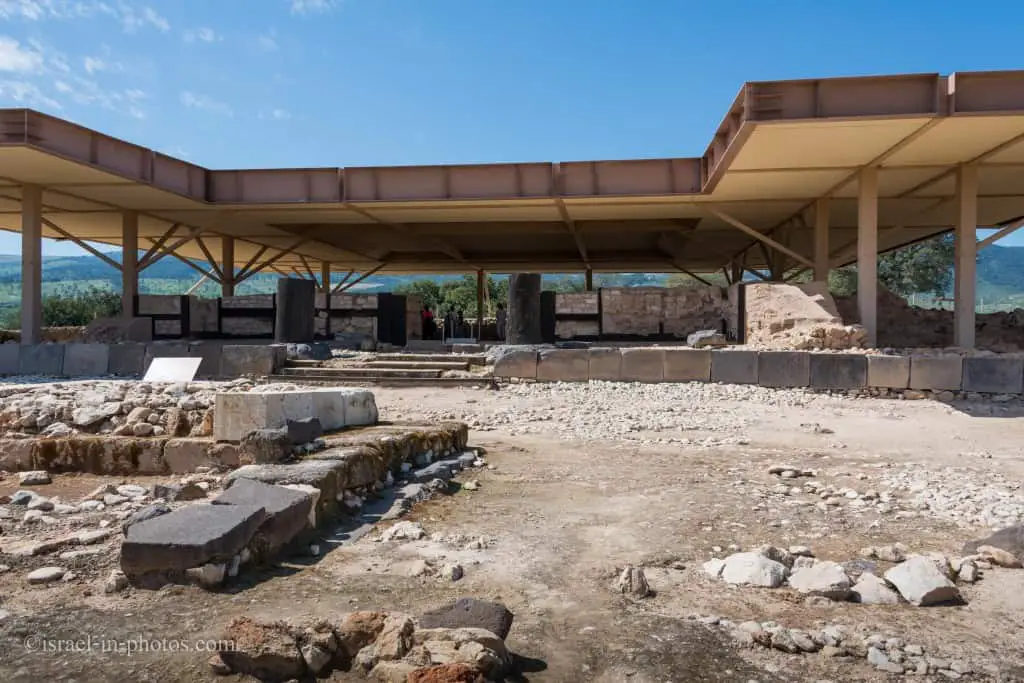
Temple or Palace
It is not very clear what was the purpose of this building. Some say it was a temple, and some say it was a palace. For example, the worship platform in front of the entrance (on the left side of the photo) supports the theory that it was a temple. But, there was also evidence found supporting it was a palace. As I understood, archaeological evidence was found supporting both theories on other sites. This means that Canaanites, at a specific period, used the palace as the temple, i.e., one building served two purposes.
At the entrance, you can see two big black tree stumps. At that time, Canaanites used Cedrus Libani. The top of this building was made of wood. Thus it did not survive. By the way, the roof you can see now is a modern one, which was put up for preservation purposes. Harsh summer sun can cause a lot of damage.
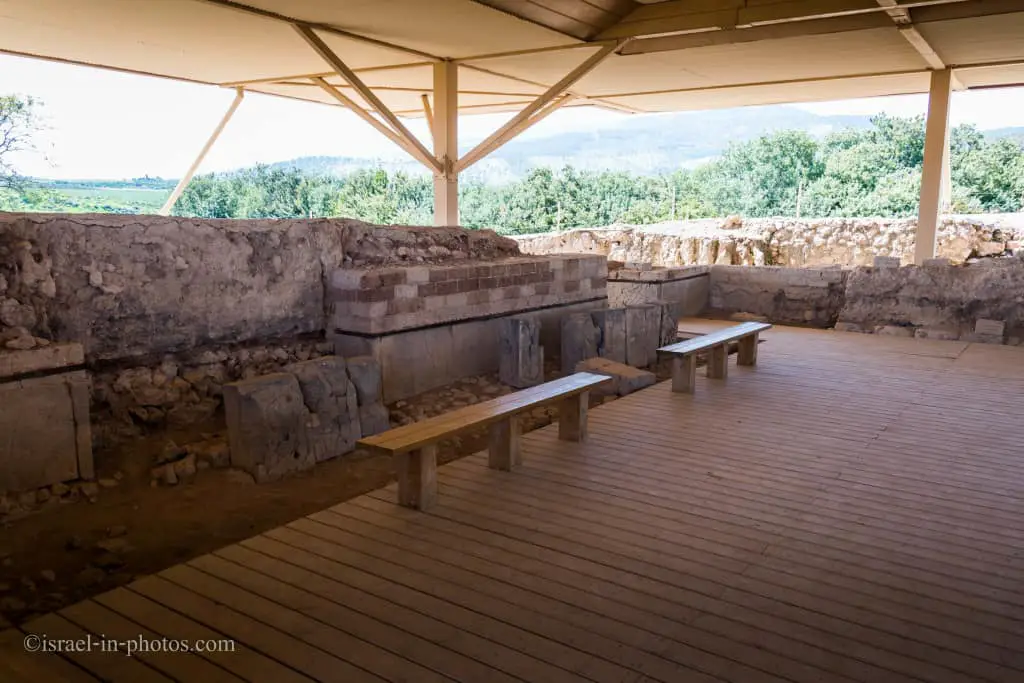
We will now return to the main question discussed in the book mentioned at the top of this post (“1177 B.C.: The Year Civilization Collapsed”).
Joshua Destroyed Hazor?
According to the Book of Joshua (11:1-5, 11:10-13), Hazor was the place of Jabin, a mighty Canaanite king that led a Canaanite alliance against Joshua. But he was defeated by Joshua, who burnt Hazor to the ground.
Despite what is written in Joshua’s Book, some scientists believe it is not what happened. The fire did occur, but Joshua did not cause it. The guide told us that they think there was a revolt. The people from the lower city rebelled and burned the king’s palace and other governmental buildings. But after they removed the king and other officials, none knew how to manage a city of such size. It led to the collapse of the Hazor. And when Joshua arrived, he saw burned remains of the town.
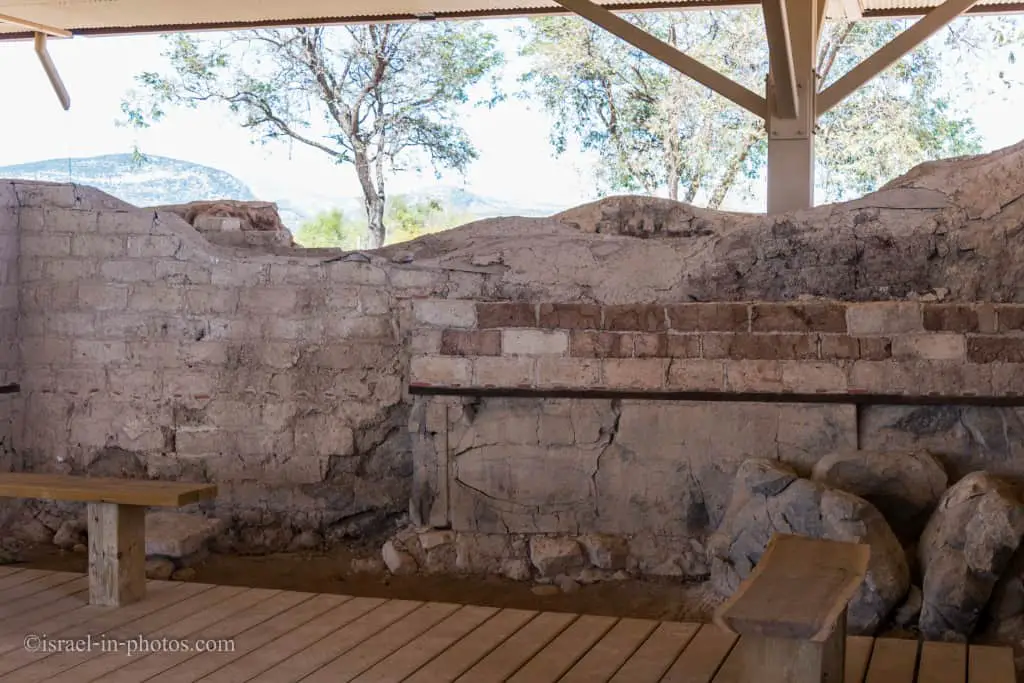
You can see that in the lower part, all stones are cracked. It is the result of a fire. But for the fire to damage stone in such a way, it must be at a very high temperature. Since this building was used as a temple, big vases with oil were inside it. That oil caused the temperature to rise and caused such damage.
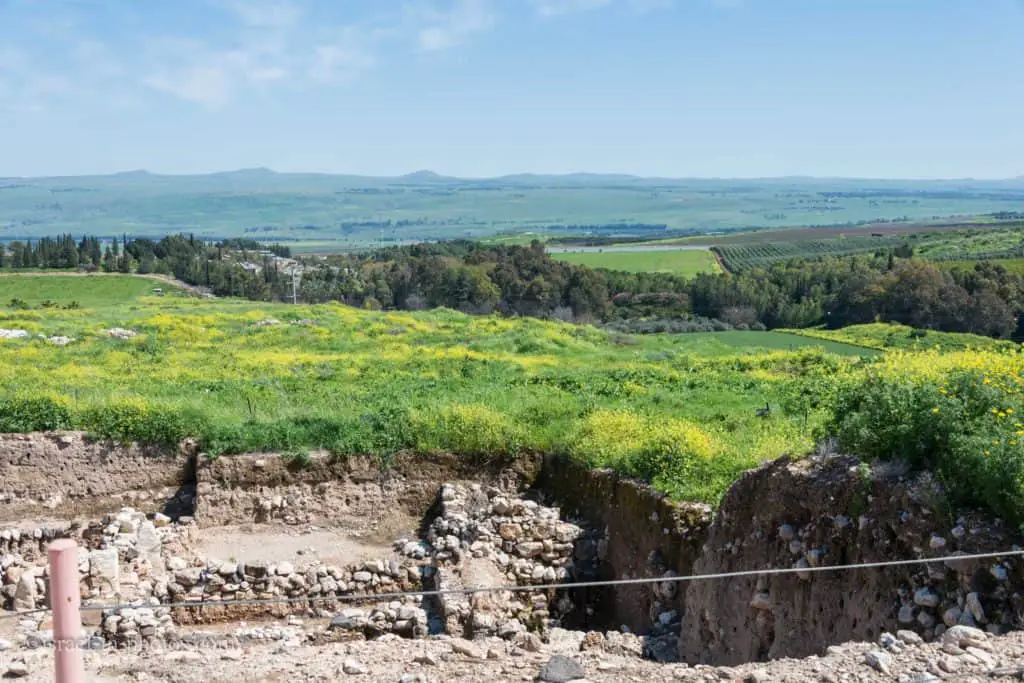
Water System
After a short walk from the temple, we arrived at the water system built by the Israelites:
The water system: One of the jewels in the crown of the visit to the site, the water system comprises three parts. The access structure is made of large ashlar blocks. Alongside this, a vertical shaft has been excavated, penetrating through the ancient layers of the mound down to the bedrock. 3 m wide steps have been carved out along its walls. It is 45 m in depth. Where the shaft ends, a 25 m tunnel begins, sloping diagonally downwards to the water-bearing deposits. The purpose of the water system was to supply residents with water even at times of drought, without having to draw it from the springs outside the city. The construction of the water system is attributed to the time of King Ahab.
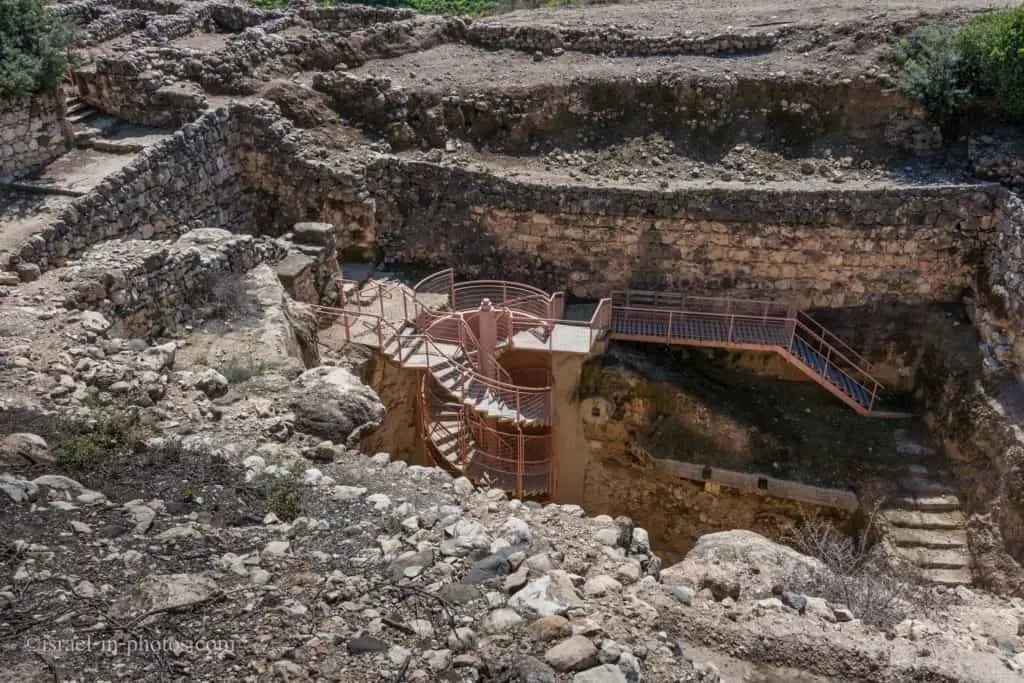
The spiral metal stairs are new ones, and the straight ones (passing on the shaft circumference) are the original ones. And if you decide to go down, be careful.
In the western part of Hazor, you can find a citadel measuring 25 x 21 meters with two-meter-thick walls. Yigael Yadin (an Israeli archeologist, politician, and the second Chief of Staff of the IDF) attributed this citadel to Ahab as well:
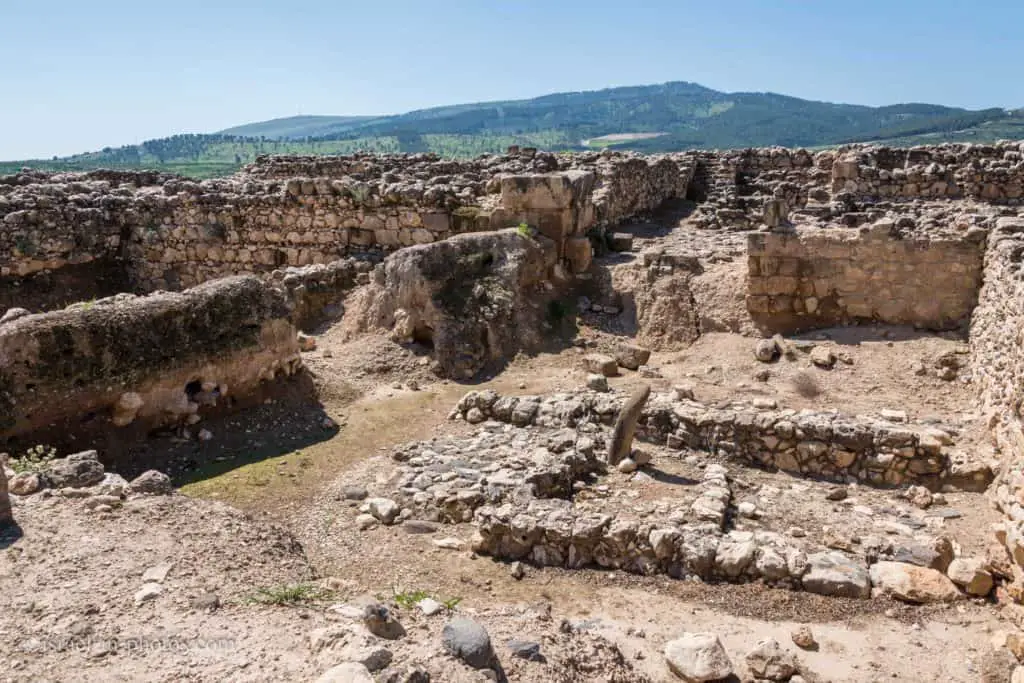
You might think that this is a small mountain. But excavation showed this, or more precisely under this, was the wall defending the lower city:

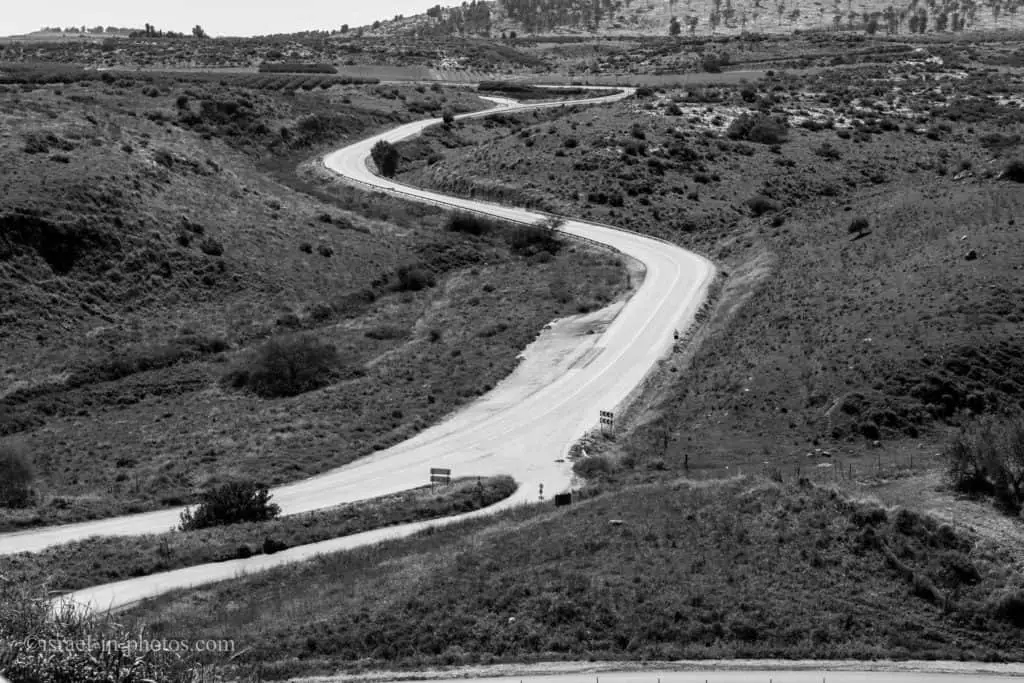
Israelite Guard
And here we are at the top of the Israelite guarding tower.

King of Spain partially funded digging at Tel Hazor National Park. And when Israeli archaeologists went to Spain (as part of a knowledge exchange), they saw similar statues on archaeological sites in Spain. The answer was straightforward when asked about the purpose of these statues. When people drive nearby and see it, they come in and ask what is there.
Thus, when he returned to Israel, they put this Israelite metal guard (but not visible from the main road). Within a week, it was stolen (by metal thieves). The police were able to find the thieves and restore the statue.
I mentioned there were three water systems. So far, we have seen the drainage of one and the shaft of another. Those two systems were small and could supply water only to the Acropolis. And this is the most extensive water system:

Yes, it was merely a big pool. It consisted of rainwater and diverted small springs. We know that today there is no winter pool here. And it could be due to several reasons: earthquakes (that moved the land) or maybe the pool’s bottom was covered with a particular layer, and over time it eroded.
Israelite Four-Room House
Remains of a four-room house in Tel Hazor National Park:
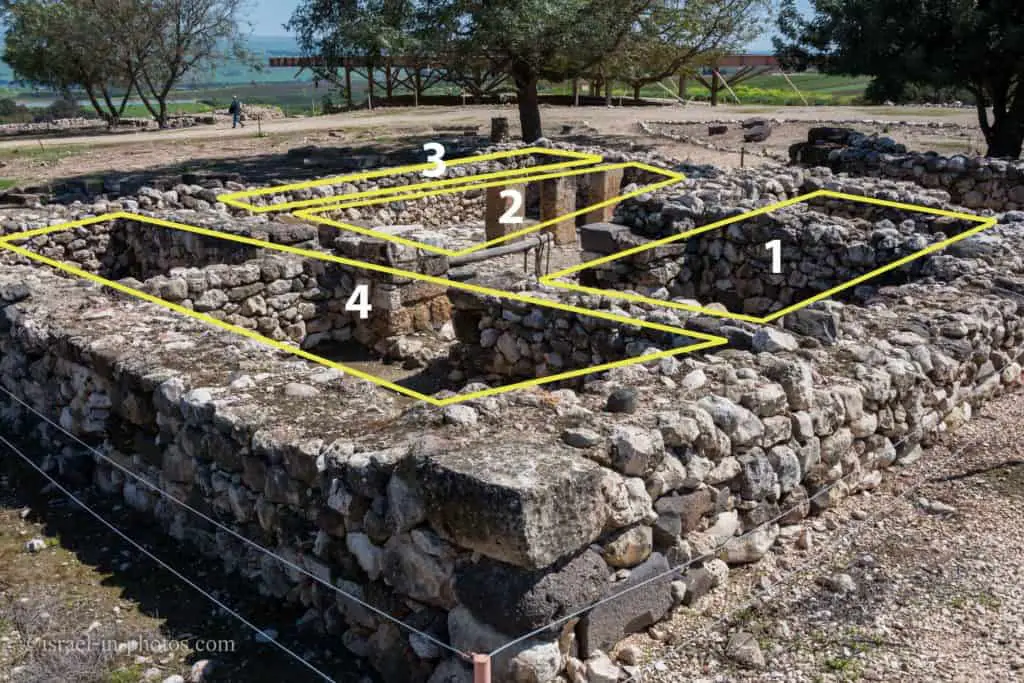
This house was originally located on the top of the template/palace and was moved here for preservation. It is a typical Israelite four-room (or four spaces) house. I have marked the four spaces with yellow rectangles. The house included a small yard (number 2) and three areas. The people lived on the second floor, and house tasks were done in the yard.
Here is the reconstructed oil press that was initially found in the yard:

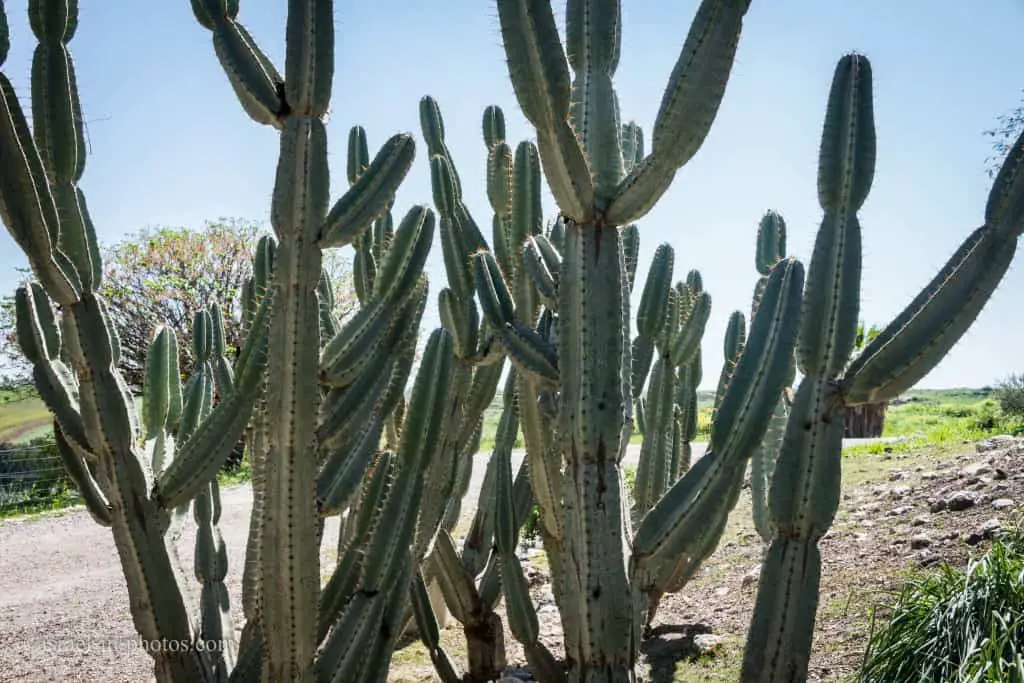
That is the end of Tel Hazor National Park, but it is not the end of the trip. Hazor antiquities museum (at the entrance to Kibbutz Ayelet HaShahar) is only several minutes of drive from there.
Hazor Antiquities Museum
When we arrived at the museum, the guide was the volunteer’s wife from Tel Hazor National Park. But the tour was much shorter this time, and she showed us the significant findings.
Opening Hours of Hazor Antiquities Museum
Sunday – Thursday: 08:00 – 17:00
Friday: 10:00 – 18:00
Saturday: 10:00 – 16:00
But before visiting, it is better to recheck and call the museum at 04-6932111
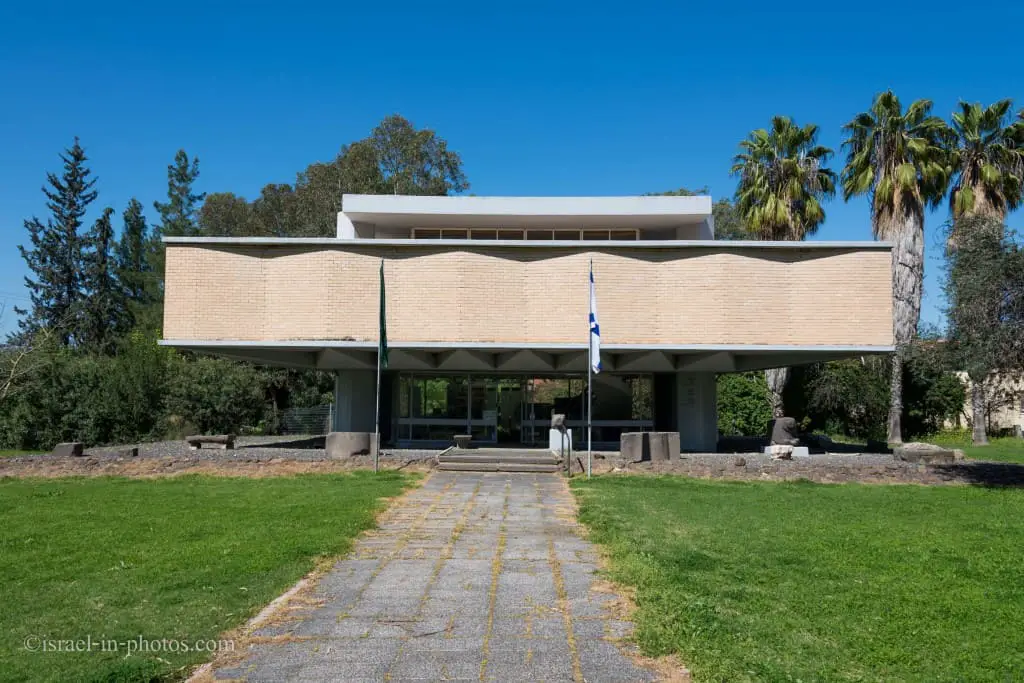
The museum is relatively small, and when something exciting is found, it is passed to the Israeli Museum in Jerusalem. Nonetheless, it is worth visiting if you are already there (to get the complete picture).
Various artifacts from Canaanite temples:
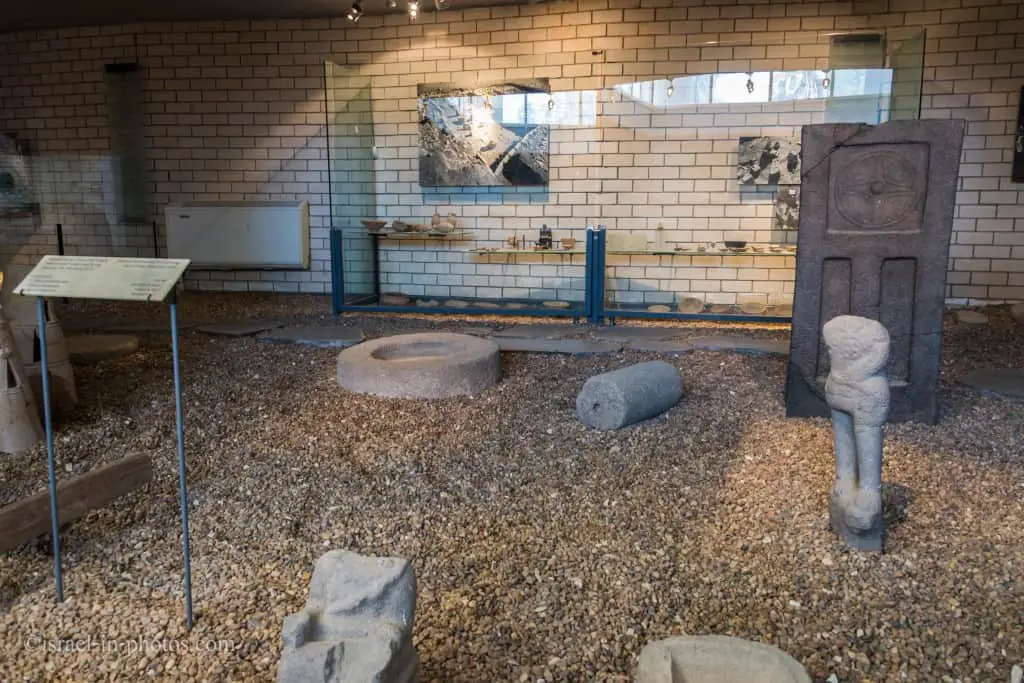
Vases:
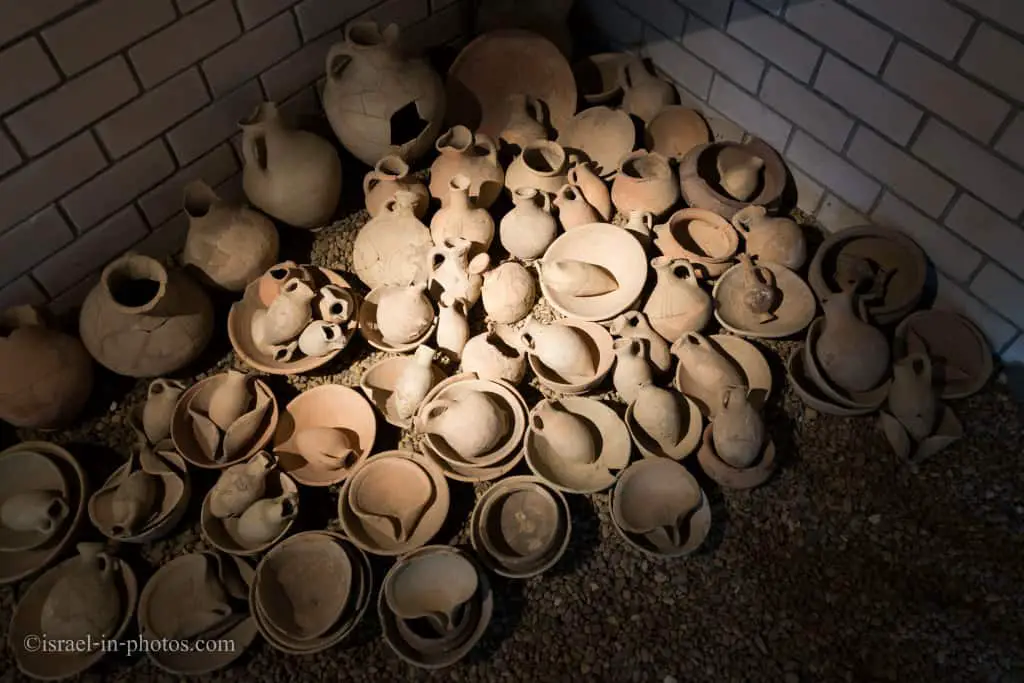

It is a cone with carving all around it, and when you roll it on clay (or some other material), you receive a repeating drawing. You can see the stamps with plates showing the resulting drawings.
Let’s see if you can guess what this is:

It is a spoon. You insert a handle and are ready to eat.
The next artifact is not that easy. What is it?

Beer in Ancient Times
It is an Israelite beer jug (with a filter). Wait. What? I know they drank wine, but beer, this is something new for me. I have checked the net, and it seems quite a popular topic. Most resources I have found rely on an article by Dr. Michael Homan in “Biblical Archaeology Review.” Here is one of those resources (http://lawsonstone.seedbed.com/2014/09/20/what-theyre-not-telling-you-about-alcohol-and-the-bible-2-2/):
Homan points out that the ancients brewed beer first by baking a barley cake and soaking it in water, which yielded a sweet liquid (called a wort). To this yeast was added, since barley does not readily ferment on its own. Soon this bubbling, bready, yeasty mix was ready to drink. It spoiled rapidly, so had to be regularly made for immediate use.
This beer had no hops or carbonation, and nor produced no “head” of foam. It would be flavored with things like honey or fruit sugars. And of course, it was drunk from a container with a built-in filter and spout, i.e., the curious artifact noted above.
One more thing worth mentioning, beer prepared in such a way had a lower alcohol level, around 2%, while today, most common beers have 4-5% alcohol.
Nearby Attractions
Here are several nearby attractions that might interest you:
- Megiddo National Park
- Banias Nature Reserve
- Tel Dan Nature Reserve
- Nimrod Fortress National Park
- Agamon Hula
Summary
We enjoyed visiting Tel Hazor National Park and the Hazor antiquities museum. I guess the main reason we were the pair of free private guides. Even without the guides, there are things to see, and visiting both places can make a marvelous half-day journey.
Have you ever been to Tel Hazor National Park? Tell us about your experience in the comments below.
That’s all for today. Cheers, and see you in future travels!
Stay Tuned!
Additional Resources
Here are several resources that I created to help travelers:- Trip Planner with Attractions and Itineraries is the page that will help you create your perfect travel route.
- What is the Best Time to visit Israel? To answer this question, we will consider the weather, prices, holidays, festivals, and more.
- Information and Tips for Tourists to Israel will answer the most common questions tourists have about Israel (including safety, passports, weather, currency, tipping, electricity, and much more).
- Israel National Parks and Nature Reserves include a complete list, top ten, map, tickets (Israel Pass, Matmon, combo), and campsites.
- If you are looking for things to do, here are the pages for Jerusalem, Tel Aviv, Haifa, Sea Of Galilee, Akko (Acre), Eilat, Nazareth, Safed (Tzfat), and Makhtesh Ramon.

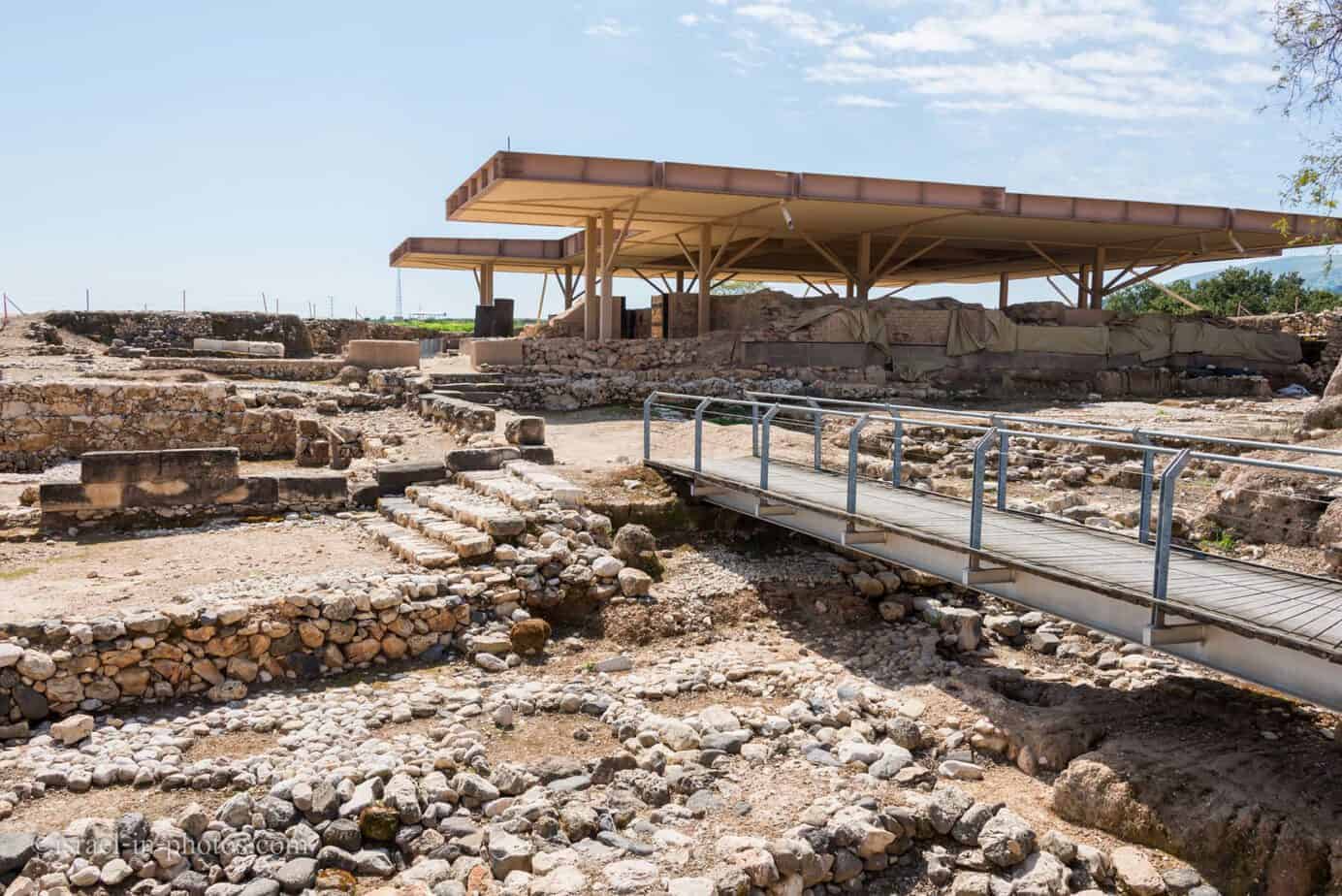






Eu estou muito agradecido por ter encontrado vosso Portal (URL) com tantas informações e fotos; há poucos dias comecei a ler o livro “…1177 b.c. …”;
See You then ! 🤝
Casimiro de Abreu, Rio de Janeiro, Brasil- 28860-000